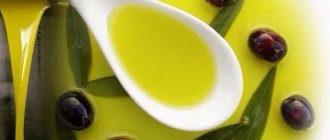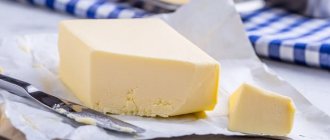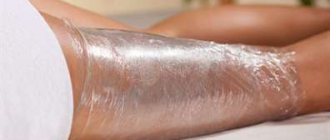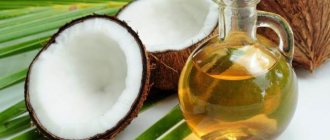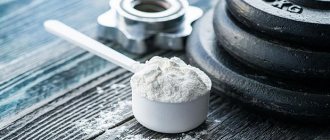What is SCT?
MCT oils (or MCT from medium-chain triglycerides) are medium-chain triglycerides that have been found in some foods, such as coconut oil.
The metabolism of these substances differs from the metabolism of long-chain triglycerides present in other foods. Triglycerides are what we call “fat” in everyday life. They penetrate the cell, where they are either burned to produce energy or stored for future use. That is, those same extra deposits are formed on the sides and stomach, which many are so eager to get rid of.
All triglycerides consist of a glycerol molecule and three fatty acids.
Basically, the human body contains long-chain fatty acids, which have from 13 to 21 carbon atoms. There are also short-chain fatty acids with a carbon chain length of up to 6 atoms and many beneficial properties.
And there are medium chain acids. Their carbon chain is 6-12 atoms.
The main medium chain acids are:
- C6 – hexane, or nylon;
- C8-octane, or caprylic;
- C10 – decanoic or capric;
- C12 – dodecane, or lauric.
Because the chain length of MCT oils is shorter than that of regular molecules, they break down faster in the body and are more easily absorbed.
Unlike other fats, MCTs go directly to the liver, rather than being stored in adipose tissue.
The body uses them for instant energy or to produce ketone bodies, which then become a source of energy.
Unlike all other fats, ketone bodies can enter the brain and nourish it in the absence of glucose. This is partly why they are so useful.
From this article you can get complete information on how to force the body to produce more ketone bodies, and how this can be useful for losing weight and improving your overall health.
The whole truth about lauric acid
The main reason that coconut oil companies claim that it is better than TSC, and MCT manufacturers claim that their product is better, is lauric acid. They are all right, but for different reasons.
MCT oil contains a combination of capric and caprylic acid, or simply concentrated caprylic acid, making it a faster, healthier source of energy. It often contains no lauric acid (C12) at all, which acts as a combination of long-chain and medium-chain triglycerides in the body and slows down the digestion process.
On the other hand, the dominant fatty acid in coconuts is lauric acid, followed by caproic acid, caprylic acid, and capric acid.
The main problem is whether it is considered a medium or long chain triglyceride. Chemists will say that it is a medium chain triglyceride, and biochemists will say that it is a long chain triglyceride. In any case, it will be right.
Lauric acid is antimicrobial, antibacterial and antiviral. It's great for the skin. It is currently being studied for its potential to help people with severe acne.
After coconut oil, its richest natural source is human breast milk, which contains up to 20% saturated fat in the form of lauric acid. There are studies that show that consuming coconut oil helps breastfeeding mothers improve the lauric acid content of their milk.
During digestion, lauric acid is converted into monolaurin, a vital substance for maintaining immune function. Most often, MCT oil does not contain it at all, although caprylic and capric acids also have some antiviral and antibacterial properties, but do not help the body create monolaurin.
Sources of MCTs
Medium chain triglycerides can be obtained either from food or from dietary supplements.
Foods with the highest MCT content are:
- coconut oil (60% of the total fat in this product);
- palm kernel oil (50%) – not to be confused with regular palm oil;
- fatty dairy products (10-12%).
Coconut oil contains the most C12 - lauric acid - up to 50%. The predominant fats in dairy products are C6, C8 and C10.
Consequences
Some athletes experienced increased energy levels when taking supplements containing TSC. They were able to do more of their usual exercises and do more cardio. If TSCs are taken regularly, this will have a positive effect on the athletic performance of each athlete.
Athletes working with heavy weights no longer experience cramps and muscle pain. They also began to feel that all the muscles of the body were in constant good tone. At the same time, the volume of subcutaneous fat decreased significantly.
Unfortunately, TSC affects everyone differently. In some cases, this supplement does not have the desired effect at all, which is why many athletes refuse it. Also, some often experience problems with the gastrointestinal tract and allergic reactions . In this case, it is recommended to stop taking medications with TSC.
Benefits for weight loss
Medium chain triglycerides help normalize weight in several ways.
- Increases the feeling of fullness. MCT fats have been shown to increase the release of the satiety hormones leptin and peptide YY more effectively than conventional long-chain oils. This helps you stay fuller longer and avoid unnecessary snacking.
- MCTs are rarely stored as body fat. Usually the body uses them immediately to produce energy.
- Against the background of consumption of MCTs (especially C8 and C10), the body more efficiently burns those fats that were already stored in reserve earlier.
- Medium chain triglycerides contain fewer calories than regular fats. And at the same time they provide more energy.
- MCT oils have a positive effect on the functioning of the intestinal microflora, which is necessary for weight loss, since in people who are overweight, the composition of the intestinal flora is altered. And this leads to further weight gain.
- MCTs increase energy potential and improve mood. This makes it possible to avoid compulsive overeating due to nervousness or simply boredom. It also allows you to move more, and therefore burn more calories during the day.
In addition, when consuming large enough amounts of medium chain glycerides, people on a low-carbohydrate diet may be able to afford more carbohydrates. Which is extremely important psychologically for many people who are losing weight.
An important nutritional component when training for weight loss
MCT fats are important for those who practice weight loss training. Typically, intense physical activity requires the use of protein-carbohydrate alternation (BUC diet).
This is not always good for those losing weight, since consuming a sufficiently large amount of carbohydrates does not allow effective weight loss. At the same time, I can’t eat a low-carbohydrate diet because I don’t have enough strength to exercise.
MCT oils, firstly, charge the body with additional energy. And, secondly, they make it possible to eat more carbohydrates without compromising the weight loss process.
Mixtures with medium chain triglycerides are not a miracle pill!
And this is important to understand. These substances help reduce weight. They make staying on an effective low-carb diet easier and more enjoyable.
But they do not provide the opportunity to lose weight by simply swallowing a capsule and without changing anything in your diet or lifestyle.
Additional information[edit | edit code]
At the molecular level, MCT oil is completely different from standard fats such as butter, margarine and vegetable oil. Standard fats are long chains of carbon, with 16 or more carbon atoms linked together in a single line, and are therefore called long chain triglycerides (LCTs). Subcutaneous fat is also LCT. Unlike LCTs, medium chain triglycerides have a much shorter carbon chain, consisting of only 6-12 carbon atoms. This is why they are called medium chain triglycerides.
Because of this molecular difference, MCT oils are digested, transported in the blood, and metabolized much faster than fatty acids from regular oils or fats and therefore have some interesting properties. First of all, MCT oils are burned in the body like carbohydrates. Unlike traditional fats, medium chain triglycerides are not stored in subcutaneous fat, but are transported directly to cells to be burned for energy.
MCT oil is burned so quickly that its calories are converted into body heat energy through the process of thermogenesis, which speeds up metabolism. The faster your metabolic rate, the more calories your body will burn.
Does this mean that by consuming medium chain triglycerides you can speed up your metabolic processes and, as a result, burn more fat? Researchers at the University of Rochester explored this possibility. In an experiment involving seven healthy men, they were asked to determine whether a single dose of MCT could speed up metabolism compared to taking LST. Participants ate test meals containing 48 g of MCT or 45 g of corn oil at different times on separate days. During the experiment, the metabolic rate increased by 12% within six hours after eating a meal with MCT, and by only 4% after eating a meal with LST. In addition, the concentration of triglycerides in plasma (the liquid part of the blood) increased by 68% after taking LST, but did not change after taking MCT. This discovery led scientists to the conclusion that replacing LCT oils with MCT oils over an extended period of time could be an effective means of weight loss.
Other researchers are not so sure on this issue. In a study conducted at the University of Calgary, in Alberta (Canada), healthy men were put on a low-carb diet that included MCT oil. Experts found that this diet had no effect on metabolic rate. Calories burned over a 24-hour period were less than 1% of total calories consumed. However, there was a decrease in the amount of muscle protein burned for energy. And while medium chain triglycerides aren't fat burners themselves, they can help maintain lean muscle mass by preventing muscle breakdown.
In most studies on MCT oils and fat loss, participants consumed huge amounts of fat—30 grams or more—to see noticeable results. But these doses are not suitable for most people, as too much MCT leads to intestinal discomfort and diarrhea. In my opinion, this approach to fat loss is simply impractical.
There is another problem associated with consuming medium chain triglycerides for fat loss. Experts recommend taking MCTs along with carbohydrates, which prevents the development of ketosis. In ketosis, byproducts of fat metabolism—ketones—accumulate when there are not enough carbohydrates to carry out the final stages of fat breakdown. But when MCT oils are taken along with carbohydrates, there is no effect on fat burning. And that's why. Carbohydrates stimulate the production of insulin, which prevents the mobilization of fat for subsequent burning for energy. Thus, there is no point in using MCT oils as a fat burner. You should act in a proven way - through exercise and proper diet.
Because medium chain triglycerides are produced in the body much like carbohydrates, it can help improve endurance levels. A good example. At the University of Cape Town Medical School in South Africa, scientists mixed 86 grams of MCT (almost 3 tablespoons) with 2 liters of a 10% glucose solution to see how it affected the performance of six trained endurance cyclists. The athletes drank a drink consisting of glucose alone, glucose plus MCT oil, or MCT oil alone. In laboratory conditions, they pedaled an exercise bike at moderate intensity for about two hours and then increased the load. They performed this approach three times, so that each athlete drank all three types of drinks once.
The cyclists drank the drink every 10 minutes. The best athletic performance was shown when athletes took a supplement of MCT and glucose. The researchers conducted further tests and confirmed that the combination preserved glycogen stores while making fat a more accessible source of energy. Thus, when combined with carbohydrates, MCT oils can improve performance during aerobic exercise by preserving muscle glycogen.
Another possible property of medium chain triglyceride oils is that they accelerate muscle growth. However, there is no verified information to confirm this fact. True, using some MCT oils to gain extra calories for high-intensity activities still makes sense. You can safely start with a dose of 1 tablespoon (7-15 ml) per day. Rapid absorption of the drug at higher doses can cause cramps and diarrhea. Before you start experimenting, consult your doctor.
Other useful properties
- Prevention of the development of metabolic syndrome . MCTs not only promote weight loss, but also prevent the development of metabolic syndrome - a group of metabolic disorders expressed in abdominal obesity, hypertension, lipid profile disorders and leading to the development of more serious diseases.
- Boosting immunity . MCTs normalize the functioning of the intestinal microflora, which helps improve the functioning of the body’s immune system, since beneficial intestinal microflora has a very significant effect on its functioning.
- Protection against viral, bacterial and fungal infections . Medium chain triglycerides strengthen the immune system and, in addition, destroy pathogens, including fungi of the genus Candida, bacteria of the genera Straphylococcus, Streptococcus and Neisseria, which are the causative agents of many, including deadly, diseases. They have MCT and antiviral activity.
- Improving brain function . MCT produces ketone bodies, which feed brain cells. A high intake of medium chain triglycerides has been shown to improve learning and memory and may even prevent the development of neurodegenerative diseases such as Alzheimer's disease.
Release form and admission rules
The following forms of MCT can be found on sale:
- Coconut oil. Most of the fat contained in this product comes from MCTs. But caprylic acid, which plays an important role in converting nutrients into ketones, makes up only 7% of coconut oil's lipids, which negatively impacts its effectiveness.
- Liquid . The most ketogenic MCTs are made by processing oil obtained from the pulp of coconut palm nuts. At room temperature, this product becomes liquid, and in the cold it hardens.
- Powder . It dissolves well and does not cause discomfort in the gastrointestinal tract.
- Emulsified . They resemble liquid ones in taste and texture, but emulsions are better absorbed and less likely to cause side effects.
- Capsules . An easy-to-take and dosage form of MCT. The soluble gelatin or cellulose shell contains triglycerides derived from coconut oil.
The method of using a dietary supplement depends on the form of its release and the content of fatty acids. It is advisable to consult with your doctor to draw up a personal schedule for taking the drug.
Coconut oil and MCT in liquid form are convenient to add to food and use for frying. When combined with a drink, the product does not dissolve, forming drops on the surface. For prevention purposes, it is enough to take 1–3 tbsp. l. It is recommended to start with a minimum dosage to make sure there is no negative reaction from the body.
Important! To prevent MCT supplements from spoiling, they should not be frozen or stored open. It is prohibited to take a drug that has expired.
The powder can be used to add to baked goods and drinks. In this case, no lumps are formed, and the texture of the dishes is preserved.
If the supplement is presented in capsule form, the manufacturer usually indicates its dosage on the packaging. Depending on the content of active substances, the daily requirement can be from 3 to 5 capsules.
What are dietary supplements with MCT?
MCT supplements contain either 100% triglycerides with caprylic acid (C8), or 100% molecules with capric acid (C10), or a combination of these two options.
Caproic acid (C6) is removed from dietary supplements because it has an unpleasant taste and odor.
Lauric acid (C12) is present only as impurities. Moreover, there is still no consensus as to whether the presence of lauric acid in MCT dietary supplements is positive or negative.
The fact is that not all researchers, in principle, classify lauric acid as medium-chain. Many believe that this is actually an ordinary long-chain molecule. This means that it does not have the beneficial properties of medium-chain molecules and actually contaminates dietary supplements.
At the same time, it was found that lauric acid has the most pronounced antibacterial and antiviral activity of all medium-chain molecules.
Inorganic and more coconut MCT oil on iHerb
Inorganic oil with medium chain triglycerides is, of course, cheaper than organic oil. And, in principle, in order to understand how your body perceives it (they say that some people experience discomfort in the stomach), you can start with inorganics. Moreover, according to the article on choosing coconut oil, fertilizers are practically not used when growing coconuts. Therefore, when choosing an inorganic MCT oil, if the health aspect is important to you, you should make sure of only the following things:
- Sourced only from coconuts, no palm oil.
- No hexane or other chemicals were used in production.
At the time of writing this review, there is only one inorganic MCT oil on sale on iHerb that meets these conditions - this one is from the Nature's Way . However, the price is not much lower than the organic options, so I don't know if it makes sense to buy it. Update : It's now organic!
The cheapest one is from the Now Foods , but the amount of each fatty acid is not indicated (and this is important!), and the specifics of production are questionable, so I cannot recommend it.
So for the first time (to basically find out how your body perceives MCT oil), I think it would be better to order this sample from Sports Research , even though it may not be ideal in terms of naturalness of production.
By the way, this product states that it contains only caprylic acid (C8), and not a mixture of three, like options in other volumes. This may be a mistake, because Sports Research caprylic acid-only MCT oil comes in a different type of bottle, and this product is not yet available on iHerb. Or perhaps not a mistake. In any case, this topic should be discussed in a little more detail...
C8 oil
As I already wrote at the beginning of the review, in the form of dietary supplements, medium chain triglycerides are usually represented by three fatty acids: caprylic (C8), capric (C10) and lauric (C12), although some disagree about the latter, since it already has too much There are 12 carbons, and it is metabolized somewhat differently. Caprylic acid with 8 carbons is considered the most medium-chain acid - it is the one that reaches the liver the fastest and in almost full volume and is burned there, converted into energy. Therefore, firstly, it is worth paying attention to its amount in MCT oil, and secondly, there are products in which almost only one caprylic acid is present.
There are such products on iHerb - here is the first one from Dr. Mercola and here is the second one from Zenwise Health . In general, their advantage is more energy from the same dose, and they are also said to be easier to tolerate by the digestive system. Minuses:
- The product is even more refined than regular MCT oil, that is, it is even more refined, and, obviously, not by natural means.
- The price is higher, even than organic options.
- Capric and lauric acids may not work as well as caprylic acid, but they have their own beneficial properties for the body, so their almost complete absence is a debatable plus.
Due to these disadvantages, I did not buy C8 oil, although I was looking at the Zenwise Health product. In addition, in the organic options I described, the largest percentage of content is still caprylic acid. And if you don’t get enough from a tablespoon, you can take more. But it’s a complete benefit, without any embarrassing moments.
Update : And yet, to know what it is, I ordered the cheapest C8 oil from Julian Bakery, which recently appeared on iHerb. Once I try it, I'll update the review.
MCT powder
Another interesting product is MCT powder, which is a mixture of medium chain triglycerides with acacia fiber. In addition to the fact that acacia actually helps make triglycerides in powder form, it is also an excellent prebiotic (I myself take one on a regular basis with good results).
MCT powder has now also appeared organic from Nutiva - here it is on iHerb. But there are also cheaper non-bio ones: for example, from Zenwise Health and from Zhou Nutrition . The latter product has a higher percentage of C8. But in principle, the disadvantage of powders in comparison with oil is that you will have to pay more for the same amount of medium chain triglycerides.
MCT oil in capsules and emulsified
MCT oils in capsules have exactly the same disadvantage - buying them is not profitable at all. But it may be more convenient for some. Although personally, I can easily take a bottle of MCT even on trips - it (and, in principle, coconut oil) does not require storage in the refrigerator, including after opening, unlike, for example, flaxseed oil, which can only be taken on a trip in the form of capsules .
It is also worth mentioning emulsified MCT oil with all sorts of additives, which can also be purchased on iHerb. It can be mixed with various liquids without resorting to a blender. However, it must be taken into account that the concentration of medium-chain triglycerides directly in such products is noticeably lower.
If anything, all of Eicherb's MCT oil (but not the powder) is here → . Perhaps you will like something else besides the products I mentioned.
Should I take supplements and how should I do it?
If you just want to increase your body's intake of beneficial nutritional compounds - medium chain triglycerides, then it is enough to use coconut oil and palm kernels, as well as consume full-fat dairy products. But if you are pursuing certain medical goals, for example, you want to lose weight, then dietary supplements with MCTs are needed.
Since medium chain triglycerides are tasteless and odorless, they can either be drunk from a spoon or used in cooking, for example, to make healthy salad dressings for weight loss.
There is no exact medical prescription indicating how much MCT you can consume per day. The usual dose of dietary supplements recommended by manufacturers is 1-3 tablespoons per day.
How to take MCT oil
It is better to start taking MCT oil with a small amount - a teaspoon, for example - to understand how your body perceives it. I read that in some people it can cause abdominal discomfort and indigestion. Having started with a teaspoon and not experiencing any negative effects, the next time I took half a tablespoon, then a whole dose, and then a full dose of 15 ml.
And although officially a teaspoon is equal to 5 ml, and a tablespoon to 15 ml, in fact, the volume of your teaspoons and tablespoons may be different. For example, I have only once encountered a teaspoon with a volume of 5 ml; usually they are 3-4 ml, and tablespoons are about 10 ml, not 15 ml. So to accurately measure milliliters, it is better to use measuring containers.
I tried taking MCT oil both with food and without food - the effect was the same. Moreover, if consumed with food, the likelihood of any discomfort in the stomach will be lower.
Some MCT oil manufacturers allow it to be used for cooking. However, due to its low smoke point, which is only 160 degrees Celsius (320 Fahrenheit), it is only suitable for cooking. Sports Research also provides recommendations for adding its MCT oil to sauces and marinades. But personally, in principle, I view this product as a healthy food supplement , not food, so I simply take it in doses, and in cooking I use other healthy fats: refined coconut oil, ghee, olive oil in salads, sometimes flaxseed oil.
Now I’ll tell you about two optimal methods of administration.
Getting the benefits of the ketogenic diet without switching to it
MCT oil is actively used by adherents of the ketogenic diet (in short, this is when fat-containing foods predominate in the diet and carbohydrates are reduced as much as possible), since it is quickly converted into ketones, which give the body energy. The ketogenic diet and ketosis itself (a state where the body switches to getting energy from fats rather than carbohydrates) has a number of positive health effects, including the treatment of cancer.
However, following a ketogenic diet strictly can be difficult or downright uncomfortable. There are a couple of tricks that can help you get almost all the benefits of a ketogenic diet without having to go on it. He gives them in his book “FOOD. What the hell should I eat?” (FOOD. What the heck should I eat?) Dr. Mark Hyman is an American nutritionist, the inventor of a diet called Pegan, in which he combined the best, in his opinion, of paleo and veganism.
The first trick is intermittent (or overnight) fasting - this is when 14-16 hours pass between dinner, which ideally should end at 6, maximum at 7 pm, and breakfast. I quote the second trick:
“The second way is to take 2-3 tablespoons of a 1:1 mixture of coconut and MCT oil 3 times a day. MCT produces ketones quickly, while coconut oil helps you produce ketones over a longer period of time. This will allow you to produce small levels of ketones throughout the day, even if you are not cutting out carbs. And it will provide you with many of the benefits of a ketogenic diet or intermittent fasting. Yes, you still shouldn't consume sugar, white flour, or other refined carbohydrates (except as an occasional snack). But you can include more starchy vegetables, nuts, whole grains and legumes in your diet. Our bodies function better when they switch from burning carbohydrates to burning fat. The same is true for our brains.”
This is how I started taking MCT oil - simultaneously with extra virgin coconut oil (the best, of course). I don’t make a mixture of them - just a tablespoon of one in the mouth and then a tablespoon of the other. The volume of my tablespoon is 10 ml - so I get 20 ml of the mixture at a time. Under normal conditions and loads it seems to be enough. At some times I can take more.
Indeed, this regimen allows you to recharge your energy and maintain it at a good level throughout the day, and also noticeably clears the brain, thinking becomes clearer and more flexible. At the same time, the last dose, which occurs at dinner, does not interfere with sleep at all.
In general, the most famous way to take MCT oil is...
Bulletproof coffee
For those who drink coffee, there is, so to speak, a cocktail called “bulletproof coffee”. It is called that because it is incredibly powerful, and consists of coffee itself, MCT oil and butter or ghee. The original recipe is:
- Brew 2 and a half tablespoons (even heaped) of freshly ground coffee in 240-360 ml of water.
- Add from one teaspoon (if you are a beginner MCT practitioner) to two tablespoons of MCT oil (the original uses Brain Octane oil, which is almost pure C8 caprylic acid).
- Add 1-2 tablespoons of butter or ghee.
- Blend in a blender for 20-30 seconds until it looks like a latte with a good amount of foam.
Well, you can further vary the recipe to your taste. I don’t drink coffee, so I haven’t tried it, but those who do are delighted with this energizing thing.


